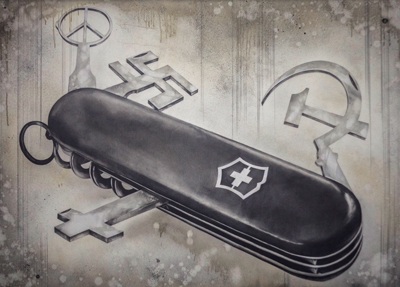[vc_row][vc_column][vc_column_text]
The Dream of Reason
By Maikel José Rodríguez Calviño
«Fantasy, forsaken by reason, produces impossible monsters: together with it, it is the mother of the arts and the origin of wonders».
Francisco de Goya y Lucientes
The Dream of Reason Produces Monsters ranks 43rd among Goya’s Caprichos published in 1799. The leading character of this disturbing etching is the engraver himself, who appears leaning on a work table. Apparently, he sleeps profoundly. From the darkness behind him emerge grotesque beings: bats, owls, cats… One of them hands him the utensils to draw, clearly indicating the dreamlike origin of the obsessions haunting the artist. Thus, the logic and rationale imposed by the mathematical equation, the written word, and the Euclidean perspective, give way to the imbalance and chaos generated by the unconscious.
With The Dream of Reason…, Goya anticipated almost one hundred years the emergence of psychoanalysis by Sigmund Freud around 1896, and more than a century the birth of surrealism, whose first Manifesto, written by André Breton, appeared in 1924. More horrors and hallucinations would come from the hand of René Magritte, Giorgio de Chirico, Joan Miró, Jean Arp, and Salvador Dali, but the great Spaniard had already intuited and reflected them in the aforementioned Capricho.
The monstrous, fruit of the impossible and the wild, is the other face of the conscious and the rational, of order and harmony. The everyday drives are encapsulated and locked in the unconscious, whose porous borders allow them to emerge and act while we sleep. Dreams are then born, habitat of a thousand and one beings resulting from the lack of control and anarchy. Something similar happens in the subjective labyrinth of the draftsman, painter and engraver Octavio Irving Hernández (Villa Clara, 1978). His most recent works refer us to a cohort of bizarre, grotesque, hallucinating creatures greatly indebted with the procedures and aesthetic premises of the surrealists, but this promising artist has nevertheless developed a suggestive and interesting language throughout his fruitful career.
Octavio is a widely recognized engraver. He masters calcography, lithography, and collagraphy with equal skill, having linked the last of these techniques with sculpture, installation and the environment. Among his main series are Objetos de mis manías (2004), Persistencia de la forma (2006), La memoria agregada (2009), Arquitectura emergente (2012) and Síntomas de la permanencia (2013). In them, transmuted, corroded, solitary and motionless ships, machinery, buildings, and city spaces become symbols of the apathy and sadness spelled out by the human being in his environment, of the mysteries that inhabit and obsess us, of eternal return, and of daily losses.
Nevertheless, in recent years Octavio has paid particular attention to an extensive series entitled Figuraciones, which submerges us into the depths of his unconscious. The powerful and expressive drawing is the basis of these creations. Also, the working algorithm, feverish and unstoppable, plays a fundamental role, since it allows the creator to deactivate the mechanisms suppressing his drives and, through the automatic gesture, to give the opportunity to the offspring of hallucination and contempt to express themselves.
Thus, a group of stubby rabbits, dogs’ heads, hooked beak birds, decadent bodies; human faces transmuted into animal faces; terrible beings that arouse compassion and look us in the eye while melting in complete silence, to seize cardboards and canvases… Predominant in this Flaubert-like zoology are horror and melancholy, the interest of an artist to explore his most profound fears and secrets, the cosmic solitude of a god without throne, and the festering decay of the dehumanized mortal. The result is disturbing and shocking. Suddenly, under the welter of seemingly unconnected strokes, we see a pair of luminous eyes emerge, watching us intently, inquiringly, and undressing us inside, or the lithographic stone transferring to the white sheet a sort of deformed doll scraping by its atrophied innocence on an inverted crescent, or the canvas is covered with teddy bears and apparently puerile snowmen that at every opportunity will twist their mouths in a disrespectful grin, roll their eyes, and show tongues and fangs.
With Figuraciones, Octavio Irving continues to address several of the issues that worry him and have defined his artistic career. I consider this series a step forward in the logical development of a born, visceral creator, capable of reaching higher levels of maturity and creativity in each new proposal. He, like the protagonist of Capricho 43 and the great surrealists, abandons himself to the mists of dream and patiently waits for the appearance of the terrifying, of fright and wonder, to lock them into engravings, paintings, drawings, and sketches that shape his particular iconographic universe.
[/vc_column_text][/vc_column][/vc_row][vc_row][vc_column][vc_gallery interval=»0″ images=»7546,7547,7548″ img_size=»1200×692″ css=».vc_custom_1550184887286{margin-top: 10px !important;}»][/vc_column][/vc_row]



